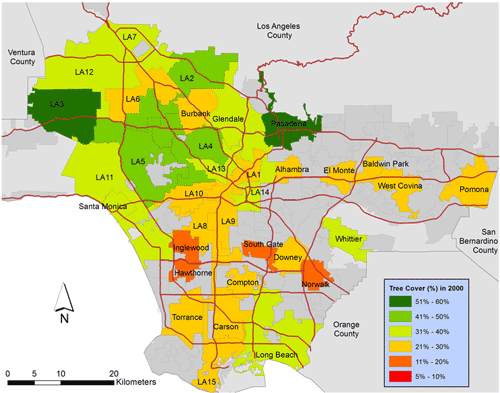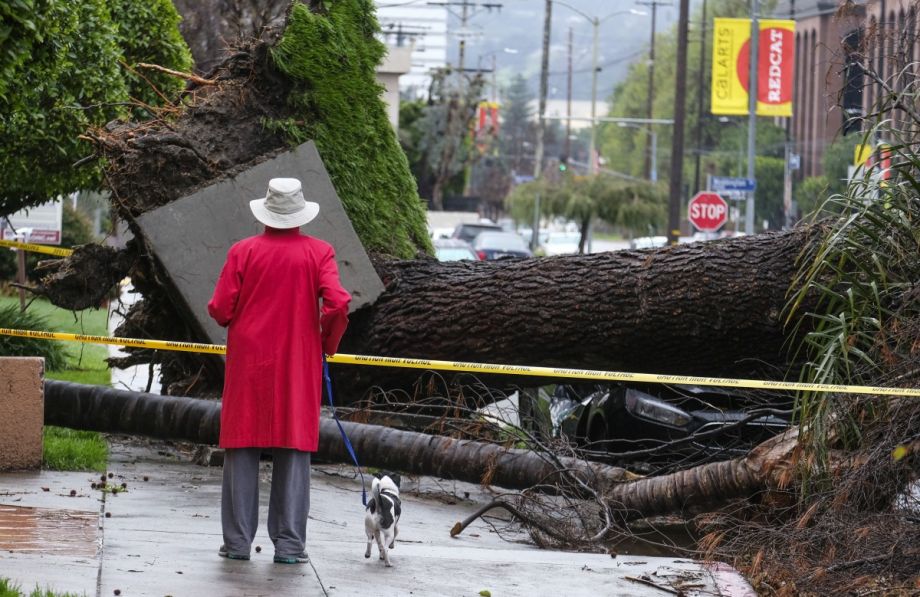When it comes to environmental justice, the focus is often on where things get placed and what impact do those things have on their surroundings. A garbage dump or a waste processing facility in a historically black neighborhood, for instance. But there’s also what doesn’t get placed, and what gets lost.
Trees and green space, for instance, have been linked to better school performance in study after study after study. So it should matter to more than urban designers and environmental activists that parts of the Los Angeles region lost as much as 55 percent of their green cover from 2000 to 2009, according to researchers at the University of Southern California’s Spatial Sciences Institute.
The researchers used high-resolution digital aerial imagery to make their determinations, focusing on trees and shrubs on single-family home lots. Here’s their visualization of the tree cover loss:

They say the change is due to a desire for bigger houses, and an increase in paved surfaces like swimming pools. From a news release about the findings:
The biggest leaf drop was in Baldwin Park, an area that’s 78.7 percent Latino and 45 percent foreign-born, and which saw a 55 percent loss of green cover on single-family residential lots, going from 70 percent green coverage to 31 percent in the span of nine years. Other areas examined had at least 20 percent loss in cover: Pomona, Downey, Sylmar, Compton, and San Pedro/Port of Los Angeles.A decade after the housing bust, property development in the age of home improvement reality television is as ambitious as ever, with new homes reaching 2,687 square feet, and nearly one-third more than 3,000 square feet, according to the U.S. Census Bureau’s annual survey in 2016.
Municipalities also often encourage redevelopment as a way to increase tax revenues.
While initial tree distribution was not equitable, it turned out that tree loss is. “We are losing tree shade across economic areas,” said one professor involved in the study. “Wealthy areas might generally have more trees to start with, but all single-family areas are losing across the board.”
The tree loss has occurred even while Los Angeles has won awards for its Million Trees campaign, one of former Mayor Antonio Villaraigosa’s signature campaign promises.
One outlier from the trend: leafy Pasadena. The city passed a tree protection ordinance in 2002. But even there, it seems, not all trees are safe. A campaign formed last year to save historic trees in Pasadena has not had much success, prompting the city council to raise fines for illegal tree removal from $108 to as much as $10,000 per offense, plus the possibility of jail time, the San Gabriel Valley Tribune reported.

Oscar is Next City's senior economic justice correspondent. He previously served as Next City’s editor from 2018-2019, and was a Next City Equitable Cities Fellow from 2015-2016. Since 2011, Oscar has covered community development finance, community banking, impact investing, economic development, housing and more for media outlets such as Shelterforce, B Magazine, Impact Alpha and Fast Company.
Follow Oscar .(JavaScript must be enabled to view this email address)



_920_518_600_350_80_s_c1.jpg)












